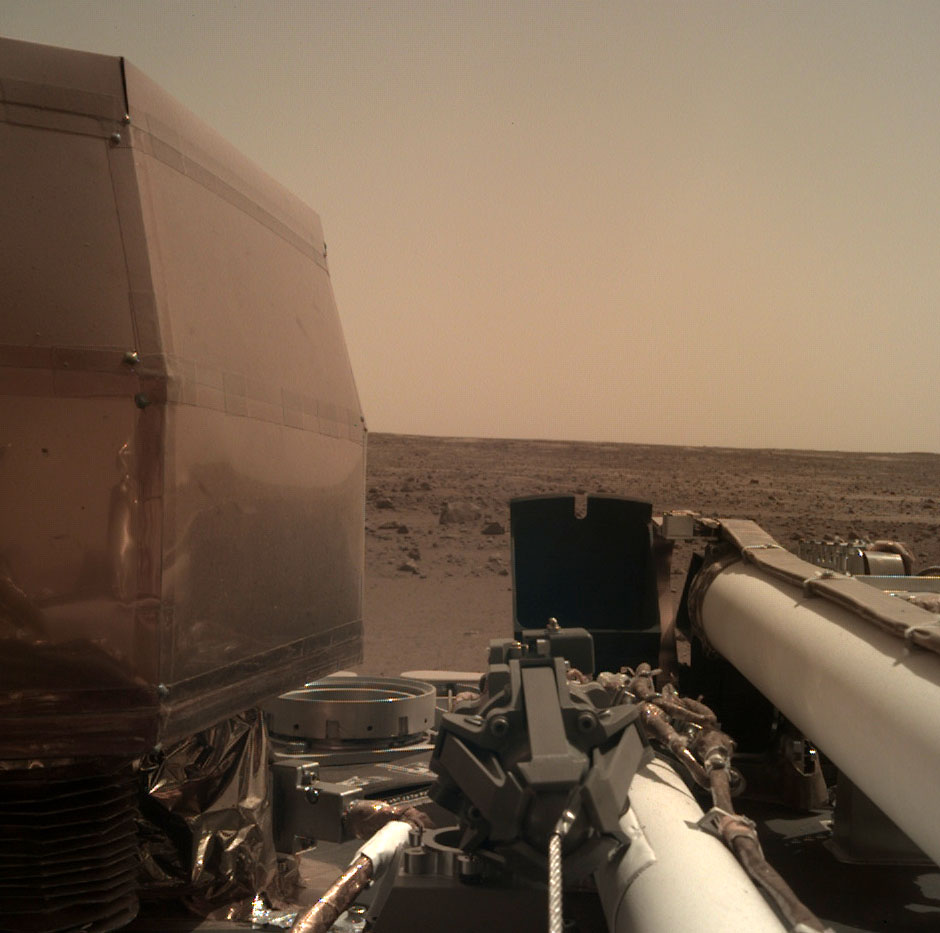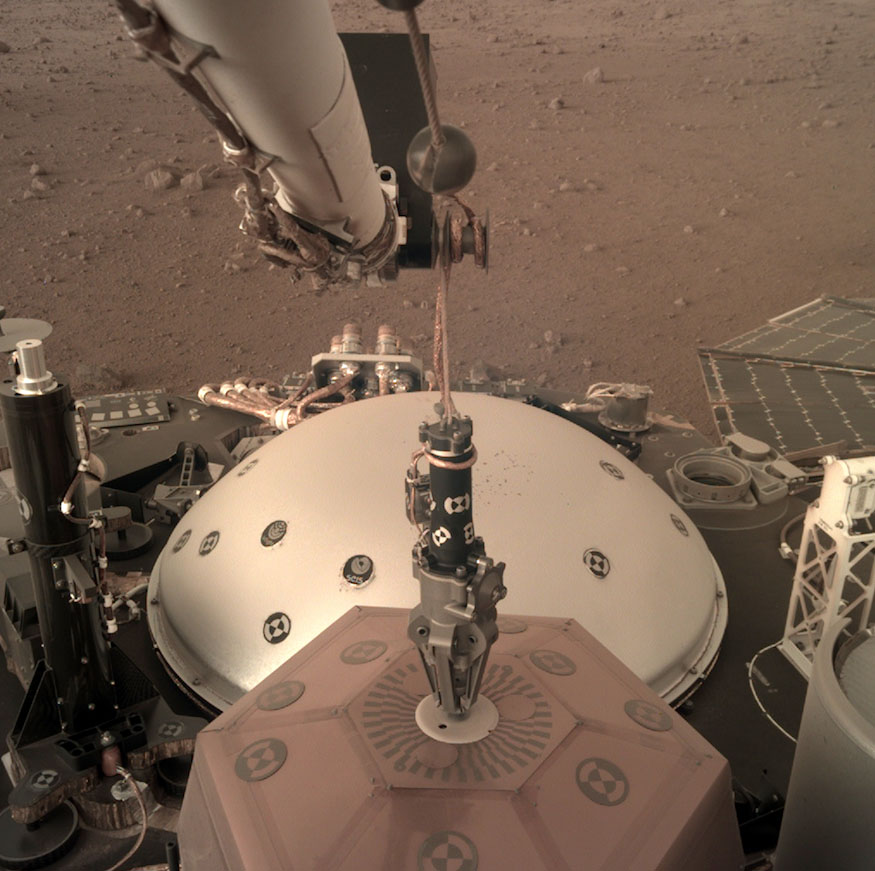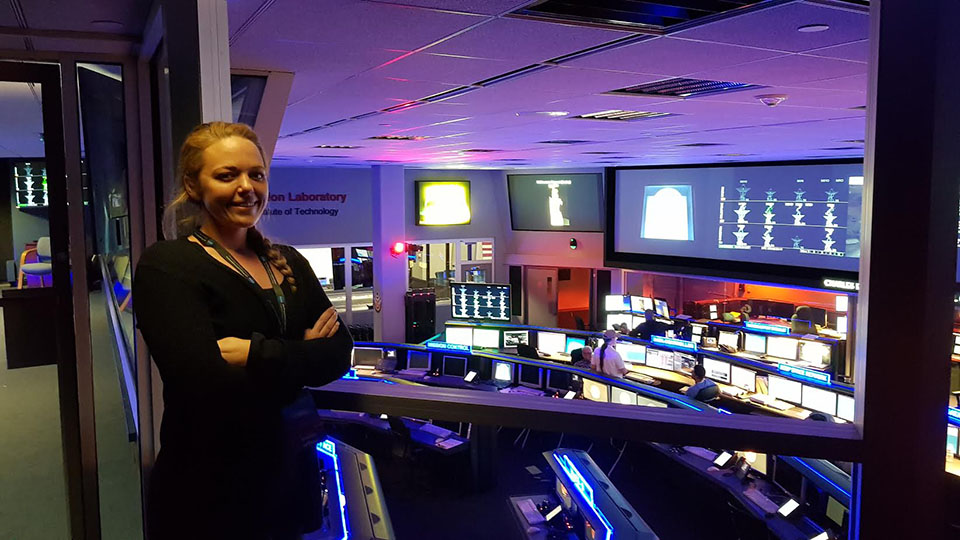CSUN Student Helps Pick the Spot for Mars Touchdown
On Nov. 26, California State University, Northridge student Heather Lethcoe watched in awe as NASA’s InSight lander approached the dusty, clay-red surface of Mars — headed for the target Lethcoe’s team helped identify.
Mars is about 140 million miles from Earth. Lethcoe, a geographical information science (GIS) junior, and a team of scientists at NASA’s Jet Propulsion Laboratory selected the ideal landing spot for InSight and its equipment with the aid of high-resolution images and data collected by NASA.
As an intern at JPL, Lethcoe’s job with InSight was to conduct surface operations. Specifically, she was tasked with selecting the best landing site for the two instruments aboard InSight — a seismometer and heat probe — which are designed to explore the interior of Mars.
“To be part of the InSight landing was truly exciting. It was really intense and surprisingly emotional for me,” Lethcoe said. “It’s a once-in-a-lifetime opportunity — especially for an undergrad like me — to be working on a project like this. I am truly humbled by the experience.”
Lethcoe works with two other interns under the supervision of Matthew Golombek, project scientist for the Mars Exploration Rover mission, and Nathan Williams, a planetary geologist with particular interest in the remote sensing of planetary surfaces.
“Heather has been of great help both with the InSight mission that landed on Mars on Nov. 26, 2018, and with the upcoming Mars 2020 rover over the past year and a half that she’s been an intern with us,” Williams said. “[Lethcoe’s] experience with GIS and eye for detail are key components we need to safely land and operate spacecraft on Mars.”
InSight, short for Interior Exploration using Seismic Investigations, Geodesy and Heat Transport, is a lander with a mission to map out the deep structure of Mars. It’s the first robotic explorer to study in-depth the inner parts of the Red Planet, including its crust, mantle and core. Studying the inner layers of the planet could reveal new insight about the early formation of planets in the inner solar system, including our own.
InSight’s seismometer and heat probe will study the planet from just one spot. The instruments will search for signals below Mars’ surface, such as marsquakes and heat.
Lethcoe has been deemed the “mapping expert” among her fellow interns because of her expertise in studying the images of Mars’ surface and then identifying the best potential landing sites for the lander to conduct its research. These high-resolution images are printed from geographical information software that Lethcoe and her team examine, searching for areas near the planet’s equator that are flat, smooth, low-lying and likely to be obstacle-free from things like rocks or hills.
“They call me the expert, but most of the time I feel like I barely know what I’m doing,” Lethcoe said. “I definitely have to rely on my team. I am very fortunate to work with such great people.”
Finding potential landing sites was no easy feat. The lander operates by using power from solar panels, so the site had to be as close to the sun as possible, making a spot close to Mars’ equator ideal. Subsurface soil is also key to a lander’s success, as it is softer, less rocky and the lowest point on the ground. For these reasons, Lethcoe and the team chose a plain called Elysium Planitia, which is a flat, smooth plain just 4 degrees north of the equator.
Landers are different from rovers in that they are not mobile. If something went wrong, like a rock blocking the robotic arm of the lander from being able to extend itself and hammer the equipment into the ground, or a small hill forcing the lander to be off kilter, the lander would not be able to do its job.
Their research paid off. Lethcoe credited her background as a U.S. Army Geospatial Engineer as being incredibly helpful to her work at NASA.
“My experience working with geographical information systems in the Army — which capture, analyze, manage and present spatial or geographic data — was crucial to me getting the internship at NASA. My advice to any student interested in getting an internship with NASA would be to get as much [work] experience as possible.”
Lethcoe was quick to add that no student should feel like an internship or job at NASA is out of reach.
“I was so nervous to start,” she said. “I didn’t think I would fit in, or be an adequate asset to the team. I didn’t come from a family of engineers or scientists — I am the first person in my family to even get an associate degree. After some time has gone on, I have realized that I really am someone who fits in there. I can be at NASA, and so can other students if they change their perspective.”
As a busy intern and full-time student, Lethcoe noted that her professors at CSUN have been incredibly understanding and flexible with her schedule.
“I really appreciate my professors here at CSUN,” she said. “They have been super accommodating with this internship, and I feel like I have no trouble getting quality time with my professors when I need it.”
Lethcoe plans to continue her education with the goal of obtaining her Ph.D. in geology or planetary science and becoming a full-time employee at JPL.
At JPL, Lethcoe is currently working on Mars 2020 related projects.
“For the 2020 mission, we will be going to Jezero Crater,” said Lethcoe. “It is a really large crater that has two deltas. The fact that the crater has not one, but two deltas, is especially exciting because deltas signify that the crater itself may have been a large lake once upon a time. This means that there is likely fluid from long ago that has been deposited into the sediments of the crater, which could prove that it was once a large body of water. The 2020 mission could teach us a lot about Mars’ composition — I am really looking forward to seeing what we discover.”




 experience
experience